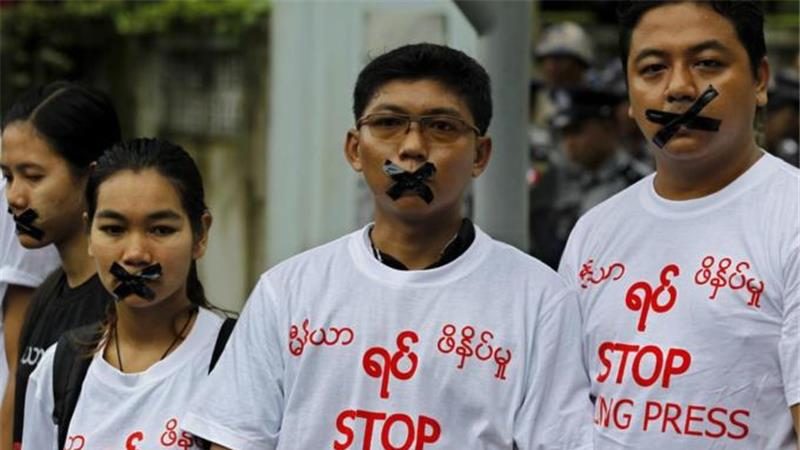How Myanmar’s media was helped in the past, and why it now matters more.
I have always admired the courage and political instincts of Myanmar’s press.
Although my knowledge is limited to English-language media, when I read what Myanmar journalists are writing I have often been impressed by how valuable and reliable the best Myanmar journalism is.
But I have also seen some Myanmar journalism which is not so impressive, a common concern in any country.
A few Myanmar journalists have received training from foreign experts and practitioners. Some of this was, in effect, “training on the job”, where foreign journalists had come to Myanmar to work alongside their local colleagues. Some of these foreign journalists were Australians who seemed to be both professional and dedicated instructors.
Another significant source of media training during the period of the military regime – that is, from 1988 – was specialist training provided overseas by international agencies which were committed to bringing democracy to Myanmar.
The main international donor was the United States, which delivered this training through government and non-government channels. The US government claims that by 2014 training in basic media skills was provided to more than 400 Myanmar journalists to support the country’s democratic transition.
Some of this media training was especially targeted at ethnic groups or women’s groups, many of which were based outside Myanmar (many were in Thailand).
The results can be seen in the impressive amount of documentary reporting produced by ethnic media networks recording from abroad the conditions in ethnic regions and the abuses these groups suffered, mostly at the hands of the Myanmar military. The anti-government character of this kind of reporting, compared to reporting emanating from journalists working inside Myanmar, is also striking.
Japan was the only other bilateral donor which included media training in its technical assistance programs during Myanmar’s military rule, much of it delivered by Japanese NGOs such as the Sasakawa Peace Foundation. Very little is known about the results.
After 2011, under the U Thein Sein government the intensity of media training increased. A few international agencies such as UNICEF, UNESCO, International Media Services and International IDEA provided in-country training in specialised areas such as health, children, climate change and election reporting.
The Australian Broadcasting Corporation (ABC) is one of the few government-funded foreign news agencies to have undertaken media training in Myanmar, in its case for its “counterpart” Myanmar-government-owned Myanma Radio and Television (MRTV). Voice of America also has a formal agreement with MRTV, and Japanese and Chinese state-funded agencies provide assistance to Myanmar as well.
Using its experience as a broadcaster with a clear national “mission” to help rural listeners, or young listeners, and to promote the arts, the ABC and MRTV signed a memorandum of understanding in 2013 under which the ABC provided specialist programming and other technical training for MRTV staff.
This interaction was not exactly collaboration between comparable organisations: The ABC has always been politically neutral in a way the MRTV could not have been.
Active participation by Myanmar in ASEAN, especially as chair in 2014, has also influenced Myanmar’s treatment of its own media. Peer pressure, for example under the U Thein Sein government, persuaded Myanmar’s leaders to seek comparable standards to its ASEAN media counterparts, even thoughmedia freedom in some ASEAN countries is not high. As a result, Myanmar media performance during its chairing of ASEAN was creditable.
As for outside assessments of press freedom, Reporters Without Borders ranked Myanmar a low 143 for 2016, with the comment that the government “seems to have opted for [closely] monitored freedom instead of the drastic censorship that was in effect until recently. So media that cover political subjects have a bit more freedom. The Burmese-language state media nonetheless continue to censor themselves and avoid any criticism of the government or the armed forces.”
According to UNESCO, Myanmar has still not ratified most of the international conventions relating to media standards.
On the other hand, while social media use has expanded very rapidly in Myanmar in recent years, censorship of social media may still be an issue. And many users still have to be careful of what they say on social platforms – so it is not yet possible to say press freedom in Myanmar is improving overall.
Yet, timely and relevant media reporting is playing a key role everywhere: in explaining Myanmar’s political developments; in disseminating the directions of economic reforms; in mobilising support for all social initiatives.
Without the energising role of Myanmar’s media, progress would falter, reforms would flounder and change would stall.
Trevor Wilson is a visiting fellow at Australian National University’s Coral Bell School of Asia Pacific Affairs, a former Australian ambassador to Myanmar and author of Eyewitness to Early Reform in Myanmar.
This article is a collaboration between The Myanmar Times and New Mandala.
 Facebook
Facebook  Twitter
Twitter  Soundcloud
Soundcloud  Youtube
Youtube  Rss
Rss 